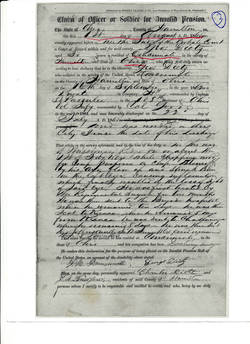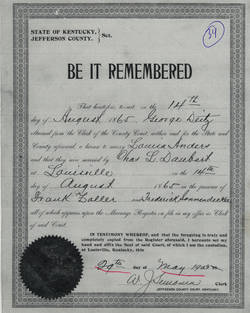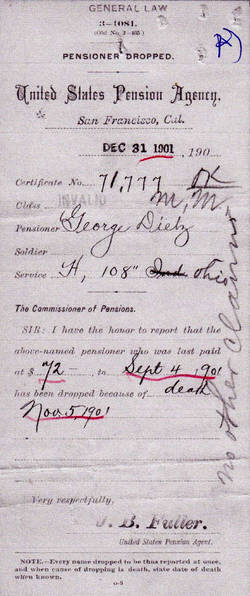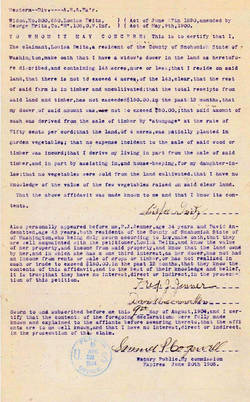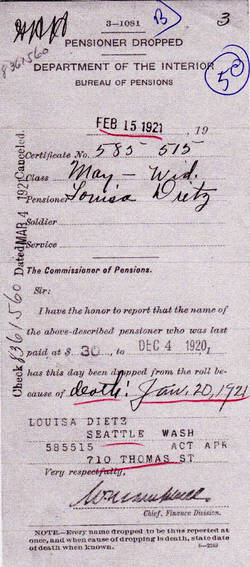George Dietz
Representing: Union
G.A.R Post
- E. M. Stanton Post #86 Arlington (Haller City), Snohomish Co. WA
Unit History
- 108th Ohio Infantry H, G, & I
Full Unit History
108th OHIO VOLUNTEER INFANTRY
Organized: Aug/Dec. 1862 to Feb.1864
Mustered In: Inf. Not Avail.
Mustered Out: 7/22/65 Louisville, KY
Regimental History
REGIMENTAL HISTORY:
Eight companies of this three year western theater regiment were organized in mid to late 1862 while the remaining groups were amassed in early 1864. Although its organization was only partially completed, as a consequence of the alarm created by the Confed. Gen. Kirby Smith's raid, it was hustled over the Mississippi River to Covington, KY. While there it received additional enlistees which brought their ranks up to 600 - still small for a Civil War regiment which generally, initially, fielded approximately 1000 men.
After a short stay in Kentucky the 108th moved into Tennessee where, at Hartsville, it met with a terrible disaster. Attack by Rebel forces under John Hunt Morgan, the unit lost 46 killed and 162 wounded. The remainder of the regiment was captured. In due time the captives were exchanged and the 108th again took to the field.
After wintering 1863/’64 in the vicinity of Chattanooga, TN the 108th entered Union Gen. W.T. Sherman's Atlanta, GA campaign which proved to be four months of almost continuous marching and fighting. At Resaca, for four hours, the regiment stood firm amidst a perfect hailstorm of bullets losing many brave men. Despite that loss, it had redeemed itself from the Hartsville debacle. At Kennesaw Mountain it was in its proper place battling for what was right.
August, 1864. Elements of the 108th found themselves in Chattanooga, TN participating in the battle for Dalton with Confederate General Wheeler's forces besieging that place. A charge was ordered and executed by the regiment with such effect as to compel the Rebels to abandon the siege. .
The 108th next participated in Sherman's "march to the sea." In the subsequent campaign northward through the Carolinas the regiment saved the day at Bentonville, NC. It was lastly engaged at the Neuse River. Final muster came in June and July.
Soldier History
SOLDIER:
Residence: Inf. Not Avail. Age: 30.6 yrs.
Enlisted/Enrolled: 9/16/62 Cincinnati, OH Rank: Pvt.
Mustered In: 9/23/62 and 12/19/62 Camp Dennison, Cincinnati, OH.
Mustered Out: 7/22/65 Louisville, KY
Highest Rank: Cpl.
Family History
PERSONAL/FAMILY HISTORY:
Although available documentation is, at best, sketchy, George Dietz was reportedly born circa March, 1832 in a district of Bavaria Germany. Nothing is known about his parentage or other possible members of his birth family.
Sometime in the 1850s George departed Bavaria/Germany and moved to the United States. Departing the region at the same time was one Barbara Sonnendecker. The two entered the U.S. at New Orleans, Louisiana, married and settled there. Barbara reportedly died circa 1859, not long after the marriage.
Although stories differ on the matter, with the outbreak of civil war in America George had at least a brush with service in the Confederate army. Likely, this was in early to mid-1862. According to one telling, while working his (unnamed) trade in New Orleans, George was taken by the rebels and forced to serve in their army until he was able to make his escape northward. As no record can be found pertaining to this alleged service, exactly how long it was and what branch of the military it may have involved cannot be determined.
As for the second telling, George, after meeting his former father-in-law and another Sonnendecker daughter in New Orleans after they arrives there from Bavaria/Germany, escorted them to Louisville, KY to live with one of their other relatives. He then returned to New Orleans. Once there, having received word that Confederate soldiers were looking for conscription into their army, he hid in a straw stack until he could escape and make his way northward where he enlisted in the Union army.
George's enlistment occurred on September 16, 1862 when he joined Captain Von Heit's company of the 108th Ohio infantry. This organization subsequently became company "H" of the 108th. At enlistment George's vital statistics were as follows: Age - 30.6 years; Height - 5'4"; Eyes - blue; Hair - sandy; Complexion - light; Occupation - carpenter. For his three year enlistment Private Dietz received a $100 bonus or "bounty", $25 of which was paid up front with the remainder to be received incrementally. While in the service George's surname would appear not only as Dietz, but also as Deats, Diette and Diete.
It appears that at enlistment George held the rank of Private and was mustered into Federal service on 9/23/62 at that rank. Other records indicate that he was also mustered on 12/19/62 and at that time held the rank of Corporal. He did not remain a corporal for long; however, as on 2/12/63 Corporal Dietz - for some undocumented reason - was reduced once again to the rank of Private. He would remain at that level of ranking throughout the remainder of his service period.
Private/Corporal/Private Dietz would spend a majority of his military career in hospitals, either suffering from some illness/injury, as a convalescent or as a nurse. His first medical notation appeared on December 16th of 1862 when he was admitted to the Camp Dennison, OH hospital for treatment of a syphilitic node. He returned to duty on December 29th. As best as can be determined syphilis was also the diagnosis when he was readmitted to the hospital on 3/20/63. On this occasion it seems he was not only a patient, but as of 5/1 was detailed on detached service as a nurse with the Invalid/Veterans Reserve Corps (see below). Returned to duty with his regiment on 11/30/63, George was again hospitalized from 12/20 to 12/22 for diarrhea at the Louisville, KY convalescent barracks.
Medical issues continued to follow Private Dietz into 1864. On February 1st, while on a wood chopping detail in the rear of Missionary Ridge, TN, a chunk of wood flew off of his axe and struck him in the left eye. For two months the injury was treated by the regimental surgeon, but with the 108th moving into Georgia with Union General Sherman's forces and the eye not getting any better, George was ordered into the brigade hospital where he reportedly remained ten days. From there he was sent to Resaca, GA for an additional five days. From Resaca he was sent to Chattanooga for another eight days and, finally, Jefferson Hospital in Jeffersonville, IN.
During this period of hospital hopping, Private Dietz was apparently inter-regimentally transferred from company "H", first to company "G" and then to company "I". Why this was done is not clear. And, perhaps it was only a paper. However, it does seem that at some point he was returned to his original company unit.
5/12/64 found Private Dietz being admitted to the Cumberland U.S.A. General Hospital located at Chattanooga, TN. Transfer to a hospital in Louisville, KY and then, perhaps again, to Jefferson U.S. General Hospital in Jeffersonville, IN followed. While exact dates for these transfers in unclear, by the middle of August Private Dietz was at the Indiana location.
Here, again, George's unit status is unclear. During the American Civil War the U.S. Army created what was first entitled the Invalid Corps and, later, the Veterans Reserve Corps. The idea was that certain soldiers who had been wounded, lost limbs or suffered from diseases contracted in the line of duty, although unfit for field service, could still be of use to the military in non-combat roles. Such was the case of Private Dietz. He had lost the use of one eye, but was otherwise physically sound. Thus, although records do not reflect him being formally transferred to the VRC's 2nd Battalion, they do refer to him as being on "detached service" with the 2nd Battalion, VRC while at Camp Detachment in Jeffersonville, IN.
During latter 1864 and up to mid-1865 when he was discharged and mustered out of the service, Private Dietz continued to move in and out of hospitals seemingly everywhere from various locations in Tennessee, Indiana, Kentucky and in Ohio. Again, available documents are confusing and even somewhat conflicting regarding these moves. Diagnosed ailments during this period included not only his damaged eye, but scurvy.
************************************
Military duty behind him George, armed with a $4 per month U.S. Government disability pension based on having lost the use of his left eye, returned to civilian life. That life, however, was not back in New Orleans, LA, but Cincinnati, Hamilton County, OH. According to an 8/1/65 pension document, his occupation after returning to civilian life was "doctoring his eyes." The word "eyes" was noted as by this time his right eye had suffered inflammation and some resultant sight loss. It was initially not known if that would prove to be temporary or permanent.
On August 1, 1865, in Louisville, KY George married Louisa Anders (b. 8/5/39 - other noted birth years include '40, ‘43 and '47.) She, too, was from George’s home area of Bavaria/Germany. How union came to be is told like this: Louisa had known the Sonnendeckers - George's first wife's relatives - in Germany. She reportedly came to American circa 1863 settling in Louisville, KY with another Sonnendecker daughter, who was then married. George, his late wife's father and a Sonnendecker brother were in partnership in some lots in Jeffersonville, IN. (Note: this business “partnership” may have been after the war had started as there is some indication that when George "escaped" northward from New Orleans he was accompanied by his late wife's father, Frederick, and brother-in-law, Frank.) The elder Sonnenecker wanted George to remarry, so he got Louisa over (to Jeffersonville, IN) from Louisville, the match was made and the two married with Frederick Sonnendecker and son-in-law Frank Zoeller - who was married to another Sonnendecker daughter - as witnesses.
After being married, George and Louisa set up household in Jeffersonville, IN where George had been "stationed" during the late war. The union would produce two children. The first George C. (b. 9/26/71 IN) would grow to adulthood and end up living in the Puget Sound region of the Pacific Northwest. While one source indicates the second child was deceased at the time of birth, a 9/30/73 document intimates the child was born alive, but apparently did not survive for long. In either case, the infant was not genderized or named.
Pension-wise, as earlier noted, George left the military with a $4 per month governmental disability pension. In 1869 - April 5th to be precise - that stipend was increased to the monthly rate of $6. By the late 1870s that amount had increased $8, but an additional increase was sought based on the following surgeon's statement written on 12/5/79: (I) believe (the soldier) is due an increase..... (He is) entirely blind in the left eye having lost same in the battle of Resaca, GA in 1864. (Additionally, he is) nearly blind in the right and gradually losing (that) sight. (He) is only able to carry on his business a by having a boy go with him." (Note: In available documents that “business” appears to be as a “lagman”. However, no such term has been found to exist.) On September 5, 1883 that blindness theme was expanded upon: “The impairment of vision is such as to require the assistance of a second party to lead him about.....Disability is first grade." Three months later, on 12/17 the following was penned: "(The) question is $50 or $72? Can the man be more blinder? If so, then $50 will do (?). If not, then $72..................(The finding is) $50 is enough, as yet." At death George was receiving $72 per month.
******************************************************************************
George, his wife, Louisa and son George C. remained in Indiana until February, 1894 when they moved to the Puget Sound area of western Washington State. However, while in Indiana they did not stay the entire time in Jeffersonville. While the U.S. Census for 1880 placed the three still in Clark County, by that date in the family was residing in Port Fulton where George, Sr. was noted as being a "merchant." With U.S. Census having been almost completely destroyed by fire in January, 1921, the family's exact location within Indiana in 1890 is not known.
In Washington the Dietz threesome settled in the small, rural, census-designated area of Snohomish County known as Oso. Within Snohomish County, Oso is located on the northern border adjacent to Skagit County. What drew the Dietz family to that remote area is not documented.
In 1898, in Washington State, George signed one pension document with his "X." As there are no prior letters or documents available known to have been signed by the old soldier, it is not known if he had ever learned to write or, as may well have been the case, by that late time in his life he could no longer see well enough to even pen his own name.
George Dietz died at his home on November 5, 1901. While the exact cause of death has not been documentally located, the following is taken from his printed obituary: "Residents of Oso were well acquainted with George Dietz. (He) lived some twelve miles from a doctor and that the road was very bad..... (He) died very suddenly after it was discovered that he was in danger and that there was no physician in attendance. We do not know the immediate cause of death, but (the) soldier was very old and blind.....sick most of the time and seemed to be suffering from old age and early exposure. (He) never seemed very well. His death was undoubtedly caused by old age and general breaking down and wearing out of his system. We believe the immediate cause of death was heart disease." At death George was (blank) years of age. Burial was in Harwood Cemetery located in nearby Arlington, Washington.
*********************************************************************
It appears that at the time of George's death, living with he and Louisa was son George C. and his wife Josephine or "Birdie." (No nee b.1880/'81 Ger.) Son George appears to have then become the head of the household and assisted his mother as she began the paperwork process to receive at least a portion of her late husband's Civil War - related pension. Pertaining to this, the following was written on 1/28/04: Widow's dower Louisa lives in Oso with her son and daughter in law. All three share the property (which is) 143 acres...of which not more than four acres have been cleared. The rest is in timber and uncultivated..... (George C.) makes his living from the sale of timber from the property and, in part, by assisting in and housekeeping from my daughter in law. No vegetables from the land cultivated are sold. At the end of that same year, the following was noted: "Claimant (Louisa) makes her ("X") mark one time and at another writes her name. She evidently cannot write anything more than her name and, that poorly (in German). Ultimately, she would receive a $30 per month stipend.
Louisa remained with son George and family for the remainder of her years. In 1910 the family unit was still in Oso, but a decade later, in 1920, was living south of there in Seattle, King County, Washington. Louisa died on 1/20/21 at the Seattle home of George and Josephine. She was buried in Arlington beside her husband.
After Louisa's passing the U.S. Government began arguing with George C. about the ownership of the family property in Oso, apparently in an attempt to determine whether or not it was his or Louisa’s. During that process the following information was provided by Josephine: “Louise lived with my husband and myself for the twenty years up to the date of her death. (This was) ever since the death of the soldier.....My husband is the soldier's only child. The night before his death the soldier called us to his bedside and expressed his wish and desire that my husband and myself were to have his property (even though he had no written will) and that we - my husband, his mother and myself - should stay together and that we should care for her. That desire and arrangement was carried out....She (Louisa) was old and feeble, but we did not consider her sick until the night before she died. She was up and around at that time." The outcome of this spat over what was considered to be $400 worth of property is not known.
Cemetery
Buried at Harwood Cemetery Arlington





